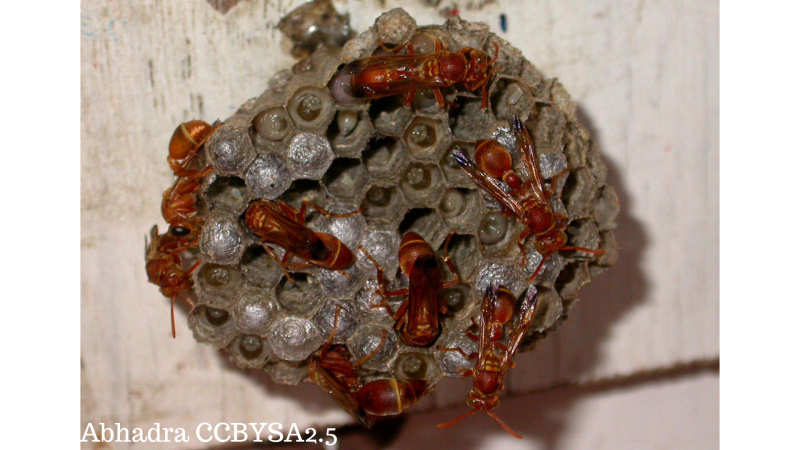
“When you're curious, you find lots of interesting things to do”, said Walt Disney. And, one such thing Dr Anindita Bhadra, now an Assistant Professor at the Indian Institute of Science Education and Research Kolkata (IISER Kolkata), did during her later PhD days was to curiously analyse huge amounts of observational data on small colonies of paper wasps (Ropalidia marginata). Who knew this casual observation of a pattern in the behaviour of these wasps could one day translate into an interesting study on how the queen wasps of these colonies control the other members?
In a recent study published in the journal Proceedings of INSA, researchers from the Indian Institute of Science, Bengaluru, have studied the pattern of dominance without aggression in Ropalidia marginata, a eusocial wasp. Eusociality is the highest level of organisation in animal societies where the young ones are raised by other members of the colony, which consist of overlapping generations of adults. There is also a strict division of labour among the members of the colony.
This division of labour in some animal societies leads to a scenario where a single female, called the queen, takes up the responsibility of reproduction. She may or may not look different from the others of the same colony. She also regulates the working structure of the community by instructing the others to work for the maintenance of the community and care for the young. Wasps are one animal society where such differentiation exists.
Small colonies of Ropalidia marginata have queens holding top ranks in the dominance hierarchy. While queens in other eusocial insect societies use aggression and suppress reproduction in workers and make them toil to maintain their position as queens, studies in the past have shown that the queens of Ropalidia marginata use pheromones to control their colonies. Pheromones are special chemicals secreted by some organisms that trigger some social response in the members of the same species. Scientists have not yet understood the reasons behind this evolutionary shift in the mechanism of the dominance of the queen.
The researchers of the current study set out to analyse observational data on the behaviour of queens in smaller colonies and compared that with those of larger colonies. “I requested people in the lab to share their data with me and got to work”, recollects Dr. Bhadra about her work. They found that queens of smaller colonies were aggressive, while the ones of larger colonies were docile. Do queens of R. marginata shift their strategy based on the size of the colony—this is the question the researchers asked and set out to find answers to.
“When I presented the results of the analysis from 100 colonies, there was a long discussion, and we agreed that we now need to simulate to check if this could be obtained by chance alone. Saikat, the first author of the study, was then a relatively new student, and he offered to do it. That's how this whole piece of work got done”, says Dr Bhadra.
The study is mostly based on observations and presents a perspective in ethology—the study of animal behaviour. The researchers isolated observations of aggressive behaviours from the data collected and analysed them further. They simulated the behaviour for 1000 iterations to eliminate the possibility of having obtained a result due to sheer statistics.
The findings of the study reveal that the queens in the R. marginata maintained aggression in small-sized colonies consisting up to 15 individuals more frequently than in the larger colonies. However, a critical colony size could not be determined below which the queen uses physical aggression to exert control over workers. The simulation results confirmed that the impression of the queen occupying top ranks in smaller colonies was indeed a statistical artefact and could be attained purely by chance.
“Dominance behaviour is used for self-regulation of the system by the workers. The queen doesn't participate in this on the whole. Her only job is to lay eggs. However, if you remove the queen, or she dies, one of the workers becomes extremely aggressive. If the queen is not returned, this aggressive worker gradually reduces her aggression level over the next week or so and goes on to lay eggs. We call her the potential queen. It's because of this very peculiar use of aggression in this species, that aggression was of so much interest to us, and especially to me because I was working on the mechanism of queen turnover for my PhD”, explains Dr Bhadra.
The behavioural transformation of the queen from aggressive control to chemical control is a critical step in the evolution of highly eusocial organisation in social insects. After meticulous observations and running a simulation, the current study concludes that this transition is a one-step process and no intermediate step exists. In the case of these wasps, the role of this dominance in social dynamics is still not well understood and needs further study on similar hypotheses.
However, there is one crucial finding—aggression may not always be required to exhibit dominance, milder ways like specific signals might be sufficient in some instances. Perhaps a lesson or two from the wasps for humans too?

























